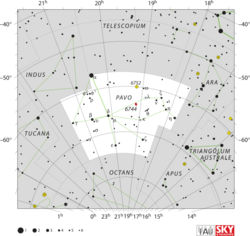Astronomy:Gamma Pavonis
| Observation data Equinox J2000.0]] (ICRS) | |
|---|---|
| Constellation | Pavo |
| Right ascension | 21h 26m 26.60484s[1] |
| Declination | −65° 21′ 58.3145″[1] |
| Apparent magnitude (V) | 4.22[2] |
| Characteristics | |
| Spectral type | F9 V Fe-1.4 CH-0.7[3] |
| U−B color index | −0.13[4] |
| B−V color index | +0.48[4] |
| Variable type | Suspected |
| Astrometry | |
| Radial velocity (Rv) | −29.9[5] km/s |
| Proper motion (μ) | RA: +80.56[1] mas/yr Dec.: +800.60[1] mas/yr |
| Parallax (π) | 107.97 ± 0.19[1] mas |
| Distance | 30.21 ± 0.05 ly (9.26 ± 0.02 pc) |
| Absolute magnitude (MV) | 4.40[5] |
| Details | |
| Mass | 1.21±0.12[6] M☉ |
| Radius | 1.15±0.04[6] R☉ |
| Luminosity | 1.52±0.05[6] L☉ |
| Surface gravity (log g) | 4.3[2] cgs |
| Temperature | 6,112[2] K |
| Metallicity [Fe/H] | –0.80[2] dex |
| Rotational velocity (v sin i) | 1.0±0.6[6] km/s |
| Age | 1.0[5] or 7.25[7] Gyr |
| Other designations | |
| Database references | |
| SIMBAD | data |
Gamma Pavonis, Latinized from γ Pavonis, is a star in the southern circumpolar constellation of Pavo. With an apparent visual magnitude of 4.22,[2] it is a fourth-magnitude star and thereby visible to the naked eye. From parallax observations with the Hipparcos satellite, the distance to this star has been estimated at 30.21 light-years (9.26 parsecs).[1] It is drifting closer to the Sun with a radial velocity of −30 km/s.[5]
Compared to the Sun, this star has a 21% greater mass and a 15% larger radius. It is a brighter star with 152% of the Sun's luminosity,[6] which is it radiating from the outer envelope at an effective temperature of 6,112 K.[2] The stellar classification of F9 V[3] puts it in the class of F-type main sequence stars that generate energy through the nuclear fusion of hydrogen at the core. It is a metal-poor star, which means it has a low abundance of elements heavier than helium. Age estimates range from a low of a billion[5] years up to 7.25 billion years.[7] Gamma Pavonis is orbiting through the Milky Way at an unusually high peculiar velocity relative to nearby stars.[citation needed]
This star has rank 14 on TPF-C's top 100 target stars to search for a rocky planet in the Habitable Zone, approximately 1.2 AU, or a little beyond an Earth-like orbit.
References
- ↑ 1.0 1.1 1.2 1.3 1.4 1.5 van Leeuwen, F. (November 2007), "Validation of the new Hipparcos reduction", Astronomy and Astrophysics 474 (2): 653–664, doi:10.1051/0004-6361:20078357, Bibcode: 2007A&A...474..653V
- ↑ 2.0 2.1 2.2 2.3 2.4 2.5 Jehin, E. et al. (January 1999), "Abundance correlations in mildly metal-poor stars", Astronomy and Astrophysics 341: 241–255, Bibcode: 1999A&A...341..241J
- ↑ 3.0 3.1 Gray, R. O. et al. (July 2006), "Contributions to the Nearby Stars (NStars) Project: spectroscopy of stars earlier than M0 within 40 pc-The Southern Sample", The Astronomical Journal 132 (1): 161–170, doi:10.1086/504637, Bibcode: 2006AJ....132..161G
- ↑ 4.0 4.1 Johnson, H. L. et al. (1966), "UBVRIJKL photometry of the bright stars", Communications of the Lunar and Planetary Laboratory 4 (99): 99, Bibcode: 1966CoLPL...4...99J
- ↑ 5.0 5.1 5.2 5.3 5.4 Holmberg, J.; Nordstrom, B.; Andersen, J. (July 2009). "The Geneva-Copenhagen survey of the solar neighbourhood. III. Improved distances, ages, and kinematics". Astronomy and Astrophysics 501 (3): 941–947. doi:10.1051/0004-6361/200811191. Bibcode: 2009A&A...501..941H.
- ↑ 6.0 6.1 6.2 6.3 6.4 Bruntt, H. et al. (July 2010), "Accurate fundamental parameters for 23 bright solar-type stars", Monthly Notices of the Royal Astronomical Society 405 (3): 1907–1923, doi:10.1111/j.1365-2966.2010.16575.x, Bibcode: 2010MNRAS.405.1907B
- ↑ 7.0 7.1 Mosser, B.; Deheuvels, S.; Michel, E.; Thévenin, F.; Dupret, M. A.; Samadi, R.; Barban, C.; Goupil, M. J. (2008). "HD 203608, a quiet asteroseismic target in the old galactic disk". Astronomy and Astrophysics 488 (2): 635–642. doi:10.1051/0004-6361:200810011. Bibcode: 2008A&A...488..635M.
External links
- Gamma Pavonis SolStation entry.
- ARICNS
 |


